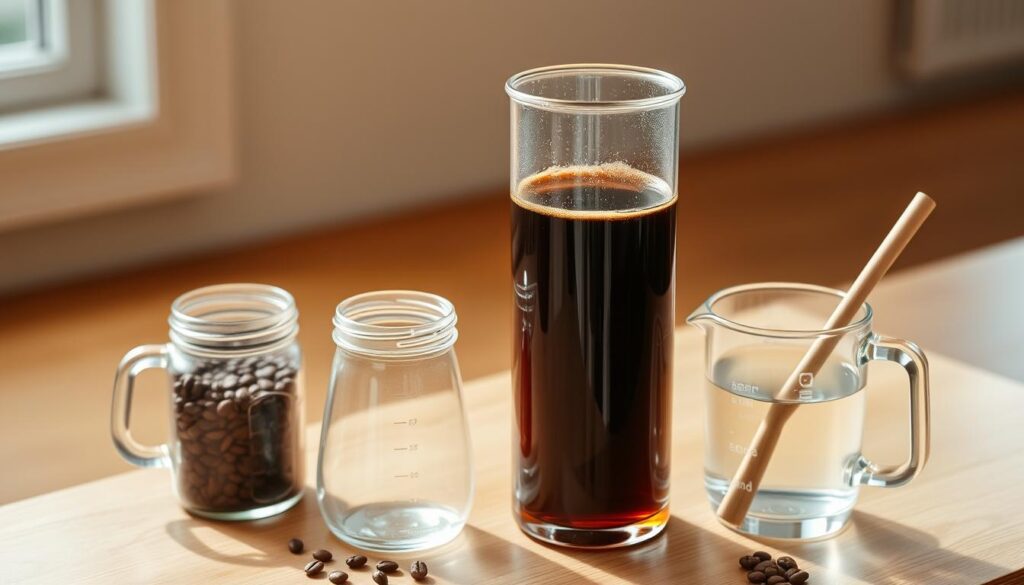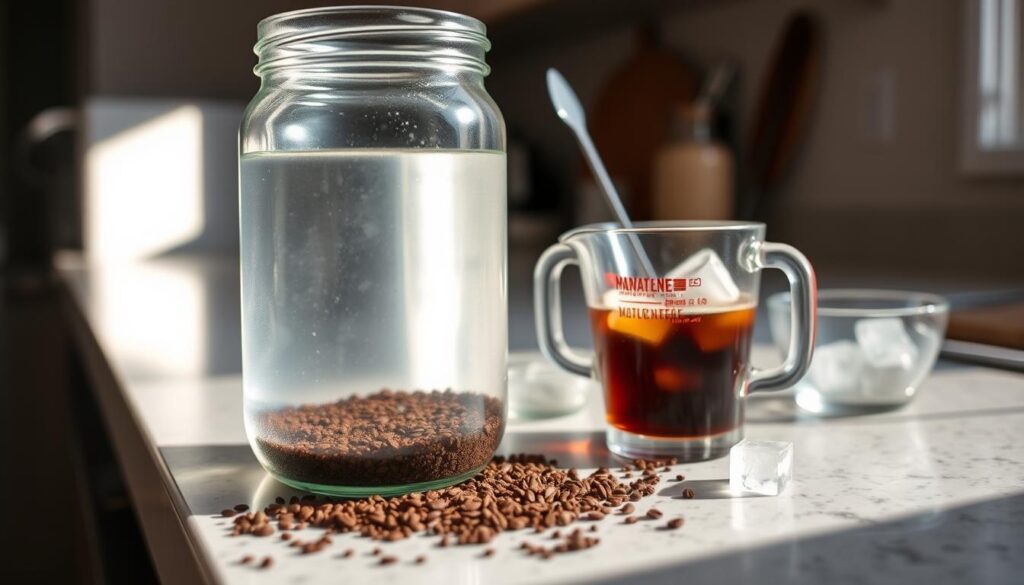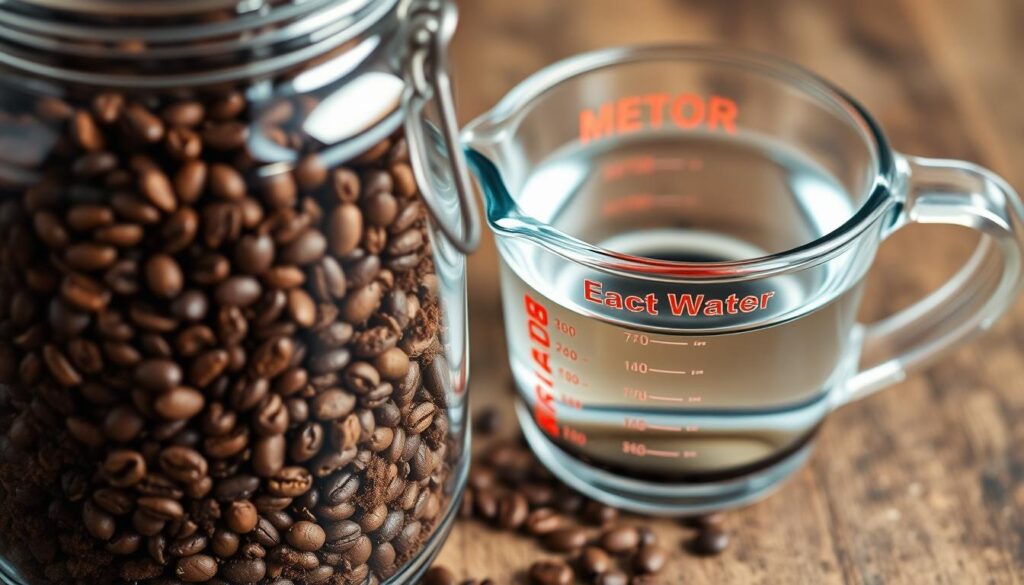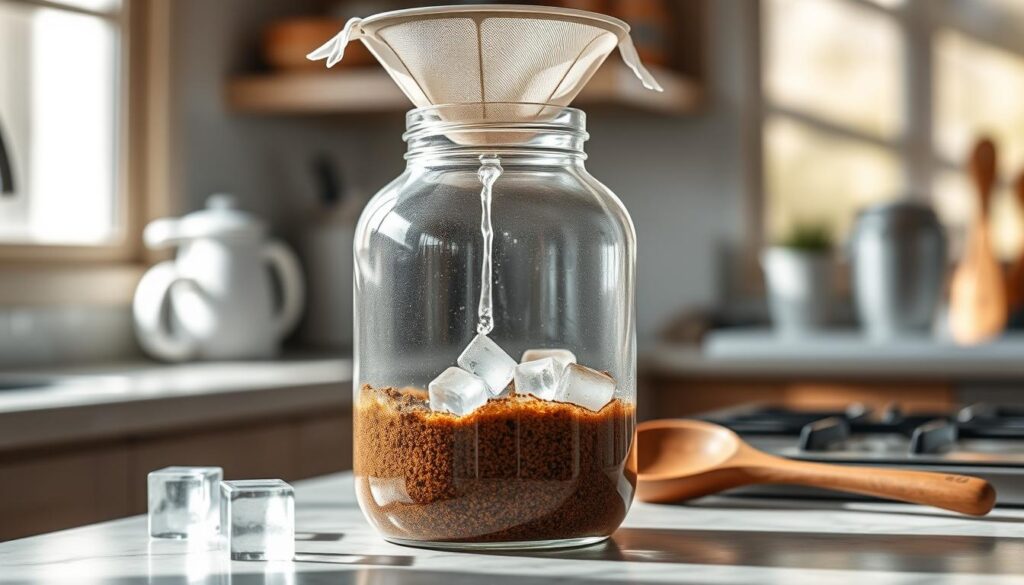Discovering the art of homemade cold brew coffee can make your morning routine more enjoyable. Cold brew coffee has a smooth, rich taste that hot-brewed coffee can’t match. This guide will show you how to make perfect cold brew in your kitchen.
Coffee lovers know that cold brew is more than a fleeting trend. It’s a way to extract deep, complex flavors slowly. Whether you drink coffee casually or are a true aficionado, learning to make cold brew will take your coffee experience to the next level.
Key Takeaways
- Cold brew requires patience and precision
- Different from traditional hot coffee brewing
- Produces a smoother, less acidic beverage
- Easily customizable to personal taste preferences
- Can be prepared in large batches for convenience
What Makes Cold Brew Different from Regular Coffee
Coffee lovers are finding a new way to enjoy their morning coffee. Cold extraction makes a unique coffee experience. It’s different from traditional brewing and offers a special drink that coffee fans love.
The Science Behind Cold Extraction
Cold extraction is a special brewing method. It uses time instead of heat to separate coffee compounds. Unlike hot brewing, it steeps coffee grounds in cold water for 12-24 hours. This slow process leads to:
- Less oxidation of coffee compounds
- Reduced bitter chemical reactions
- Smoother flavor profile
Flavor Profile Characteristics
Cold brew coffee has a smooth taste that’s different from hot-brewed coffee. The cold extraction method makes it less acidic. This makes it easier on the stomach and more enjoyable for those who are sensitive.
| Characteristic | Cold Brew | Traditional Coffee |
|---|---|---|
| Acidity Level | Low | High |
| Flavor Intensity | Smooth | Robust |
| Bitterness | Minimal | Pronounced |
Health Benefits of Cold Brew
Cold brew is not only tasty but also good for you. Its unique extraction process keeps more antioxidants than traditional brewing. These antioxidants fight off free radicals and boost overall health.
“Cold brew isn’t just a beverage, it’s a healthier way to enjoy your daily coffee ritual.” – Coffee Research Institute
For those looking for a gentler, more flavorful coffee, cold brew is a great choice. It’s a unique alternative to traditional brewing methods.
Essential Equipment and Ingredients for Cold Brew Success
Making the perfect cold brew is more than just coffee and water. The right cold brew equipment can make all the difference. It turns your home brewing into something truly special.

Starting your cold brew adventure means investing in top-notch tools. Here’s what you’ll need:
- Coffee grinder with adjustable settings
- Large glass mason jars for brewing
- Fine mesh filtration system
- Measuring tools for precise ratios
The coffee grinder is key in cold brew making. Choose a burr grinder for consistent, coarse grinding. Coarse grounds prevent over-extraction and ensure smooth, balanced flavors.
Mason jars are great for cold brew lovers. Their wide-mouth design is perfect for brewing and storing. With a good filtration system, you’ll get a clean, sediment-free brew every time.
“The right equipment transforms cold brewing from a technique to an art form.” – Coffee Brewing Experts
Your filtration system should keep grounds out while keeping flavors in. Look at paper filters, fine mesh strainers, or cold brew filter bags. They help you get the clarity and taste you want.
The Ultimate Guide to Cold Brew Coffee: Step-by-Step Instructions
Making the perfect cold brew needs focus and knowledge of coffee-making. Each step is important for a smooth, rich, and tasty cold brew. It’s different from hot brewing methods.

Good cold brew starts with three things: coffee bean choice, grind size, and water quality. These elements combine to make great cold brew coffee.
Selecting the Right Coffee Beans
Choosing the right coffee beans is key. Go for high-quality, medium to dark roast beans. They should have rich, bold flavors. Single-origin beans from places like Ethiopia or Colombia are best for complex tastes.
- Choose whole beans with recent roast dates
- Look for beans with chocolate, nutty, or caramel notes
- Avoid overly light or overly bitter roasts
Determining the Perfect Grind Size
Grind size is crucial for cold brew. A coarse, even grind lets water soak through well. This is important for flavor during the long steeping time.
| Grind Size | Recommended Use | Extraction Characteristics |
|---|---|---|
| Coarse | Cold Brew | Smooth, Less Acidic |
| Medium-Coarse | Alternative Cold Brew Methods | Balanced Flavor |
| Fine | Not Recommended | Over-Extracted, Bitter |
Water Quality and Temperature
Use filtered water at room temperature for the best cold brew. Tap water can add unwanted minerals or chlorine. This can ruin the coffee’s natural taste.
“Great cold brew starts with great water” – Coffee Brewing Experts
Room temperature filtered water is perfect for brewing. It extracts coffee’s flavors slowly. This avoids bitterness or acidity found in hot brewing.
Mastering the Coffee-to-Water Ratio
Getting the coffee-to-water ratio right is key to perfect cold brew. This balance affects the coffee’s strength and taste. Cold brew fans say the right amount makes all the difference.

The usual cold brew ratio is between 1:4 and 1:8. This depends on how strong you like your brew. Here’s a quick guide:
- Light concentration: 1:8 ratio (more water)
- Medium concentration: 1:6 ratio (balanced strength)
- Strong concentration: 1:4 ratio (more coffee)
Adjusting the strength isn’t just about adding coffee. It’s about how the ratio changes the taste. A higher ratio means a stronger brew that you can dilute later.
“The secret to exceptional cold brew lies in precise ratio control and patient extraction.” – Coffee Brewing Experts
Pro tip: Begin with a medium ratio and adjust to your liking. Some like their brew strong for mixing, while others prefer it milder.
| Ratio | Coffee Amount | Water Amount | Flavor Intensity |
|---|---|---|---|
| 1:4 | 250g | 1000ml | Strong |
| 1:6 | 167g | 1000ml | Medium |
| 1:8 | 125g | 1000ml | Light |
Remember, making cold brew is an art. Your taste, equipment, and beans will guide your brewing method.
Steeping Time and Temperature Control
Making the perfect cold brew needs careful attention to steeping time and temperature. Knowing these details can make your coffee experience much better.

Cold brew extraction is an art that requires focus on time and temperature. The time you steep it affects the flavor and smoothness of your coffee.
Finding Your Ideal Brewing Duration
- Minimum steeping time: 12 hours
- Optimal steeping duration: 16-24 hours
- Maximum recommended steeping time: 36 hours
Steeping for less time makes your coffee lighter and less strong. Steeping for longer makes it richer and more intense.
Storage Temperature Guidelines
Keeping your cold brew in the fridge is key to its quality. Store it between 35-40°F to keep it fresh and prevent bacteria.
Signs of Perfect Extraction
- Smooth, rich color without bitterness
- Consistent texture without sediment
- Clean, balanced flavor profile
“The magic of cold brew lies in its patient extraction process.” – Coffee Enthusiast
Try different steeping times to find your perfect cold brew. Start with the usual times and adjust to your liking.
Pro tip: Use filtered water and high-quality beans for the best extraction results.
Filtering and Storage Methods
Cold brew filtration is key to a smooth, tasty coffee drink. Both pros and home brewers agree: the right filter makes a big difference.
There are many ways to filter your cold brew. Each method changes the taste and feel of your coffee. Here are some top choices:
- Paper filters for ultra-smooth extraction
- Fine mesh strainers for quick separation
- Cheesecloth for traditional filtering
- Reusable cloth filters for sustainable brewing
Choosing the right container for your cold brew is important. It keeps the flavor fresh and prevents bad smells. Glass containers with tight lids are best.
“The right storage method can extend your cold brew’s shelf life from 3 to 7 days with minimal flavor degradation.”
Keeping your cold brew fresh is a must for coffee lovers. Here’s how to keep it tasting great:
| Storage Method | Temperature | Expected Shelf Life |
|---|---|---|
| Refrigerated (Sealed Container) | 35-40°F | 7-10 days |
| Room Temperature | 68-72°F | 12-24 hours |
| Freezer Storage | 0°F | Up to 2 months |
Pro tip: Always strain your cold brew completely and store in an airtight container to maximize its shelf life and preserve its rich, smooth flavor profile.
Creating Cold Brew Variations and Recipes
Cold brew coffee opens up a world of delicious possibilities. Whether you love coffee or just enjoy a good drink, trying new cold brew recipes can make your caffeine fix special.
Creating unique cold brew variations is all about being creative and trying new things. Cold brew coffee is so versatile that you can make it your own, no matter what you like.
Classic Cold Brew Preparations
- Traditional smooth cold brew concentrate
- Nitro cold brew with creamy texture
- Iced cold brew with milk or cream
Flavor Infusion Ideas
Make your cold brew recipes even better with exciting flavors. Some great ways to add flavor include:
- Vanilla bean extract
- Cinnamon stick steeping
- Lavender essence
- Caramel syrup blending
Cocktail Inspirations
Turn your cold brew into fancy coffee cocktails that wow your friends. These drinks mix classic mixology with the deep flavors of coffee:
| Cocktail Name | Key Ingredients | Preparation Style |
|---|---|---|
| Cold Brew Martini | Vodka, cold brew, coffee liqueur | Shaken, served chilled |
| Irish Cold Brew | Whiskey, cold brew, cream | Layered, smooth blend |
| Espresso Martini Twist | Cold brew, rum, chocolate liqueur | Blended, garnished |
These coffee cocktails show how amazing cold brew can be. It’s more than just a morning coffee.
Troubleshooting Common Cold Brew Problems
Cold brew coffee can be tricky to perfect. Brewing challenges like weak flavor, over-extraction, bitterness, and cloudiness often frustrate coffee lovers. Understanding these issues helps make a smooth, delicious cold brew every time.
Let’s explore the most common cold brew problems and their solutions:
- Weak Flavor: Often results from too little coffee or a short steeping time. Increase your coffee-to-water ratio and extend brewing duration for a more robust taste.
- Over-extraction: Too long steeping can lead to harsh, bitter coffee. Stick to recommended brewing times – typically 12-24 hours at room temperature.
- Bitterness: Choose coarse-ground beans and avoid pressing or squeezing grounds during filtering to minimize bitter compounds.
- Cloudiness: Use high-quality filters and avoid agitating coffee grounds during brewing to achieve a crystal-clear cold brew.
“Perfect cold brew is an art of patience and precision” – Coffee Brewing Expert
Water quality is key in preventing these issues. Use filtered water and maintain consistent brewing temperatures for optimal results.
Experimentation is key to mastering cold brew. Each batch offers an opportunity to refine your technique and develop a personalized brewing method.
Conclusion
Making great cold brew coffee is an art that mixes science, passion, and practice. With each batch, your coffee skills grow, turning simple ingredients into a special drink. The techniques you’ve learned are a solid base for exploring the rich world of cold brew coffee.
Brewing confidence comes from knowing the cold extraction process well. Every step, from picking the best beans to mastering steeping, makes a great coffee experience. Remember, cold brew mastery is a journey of learning, where trying new things and being patient lead to tasty results.
Feel free to change these techniques to fit your taste. Every coffee lover starts somewhere, and your skills will grow with practice. With knowledge on bean selection, water quality, and extraction, you can make cafe-quality cold brew at home.
The world of cold brew is vast and exciting. Your new skills open up endless flavor possibilities, from classic to new recipes. Enjoy the journey, trust your taste, and savor the smooth, cool taste of a perfectly made cold brew coffee.
FAQ
How long can I store homemade cold brew coffee?
You can keep homemade cold brew in the fridge for 7-10 days. It stays fresh and flavorful. Always use a tight container and keep it cold.
What’s the difference between cold brew and iced coffee?
Cold brew is made by steeping coffee in cold water for 12-24 hours. It’s smoother and less acidic. Iced coffee is hot coffee served over ice, which can be more bitter.
Can I make cold brew with any type of coffee beans?
You can use any coffee beans, but medium to dark roast is best. Beans with chocolate, nutty, or caramel notes make a richer cold brew.
Do I need special equipment to make cold brew at home?
No, you don’t need expensive gear. A large mason jar, fine-mesh strainer, or cheesecloth works well for making cold brew at home.
How strong is cold brew coffee?
Cold brew is stronger than regular coffee. People usually dilute it with water, milk, or ice. The usual mix is 1 part concentrate to 1-2 parts liquid.
Is cold brew less acidic than regular coffee?
Yes, cold brew is about 67% less acidic than hot coffee. The cold process reduces acidity, making it easier on the stomach.
Can I heat up cold brew coffee?
Absolutely! You can heat cold brew concentrate for a warm drink. Mix it with hot water or warm it gently without losing its smooth taste.
What’s the best grind size for cold brew?
Use a coarse grind, like breadcrumbs, for cold brew. This prevents over-extraction and makes filtering easier. Fine grinds can make the brew cloudy and bitter.
How much coffee should I use to make cold brew?
Use 1 cup of coarse coffee grounds for 4 cups of water. This makes a strong concentrate. You can adjust the ratio for your taste.
Can I make cold brew with decaf coffee?
Yes, you can make cold brew with decaf coffee beans. The process works the same, giving you a smooth, low-acid coffee without caffeine.
Share this post: on Twitter on Facebook

